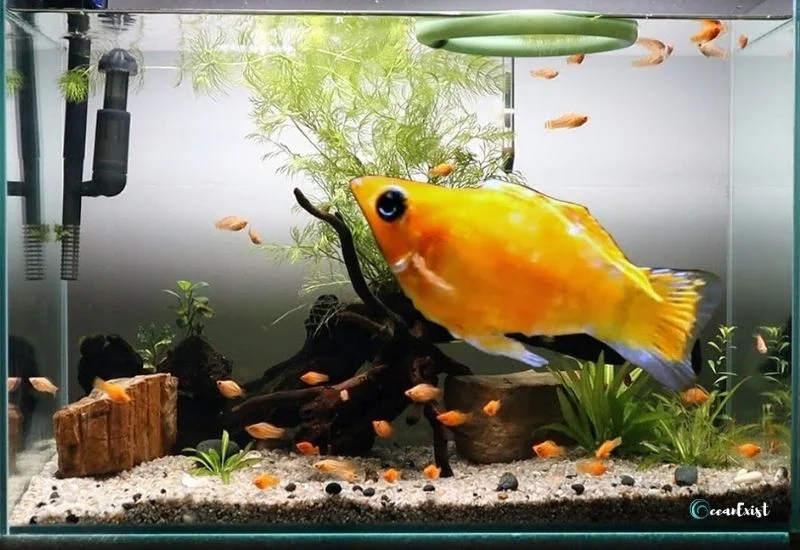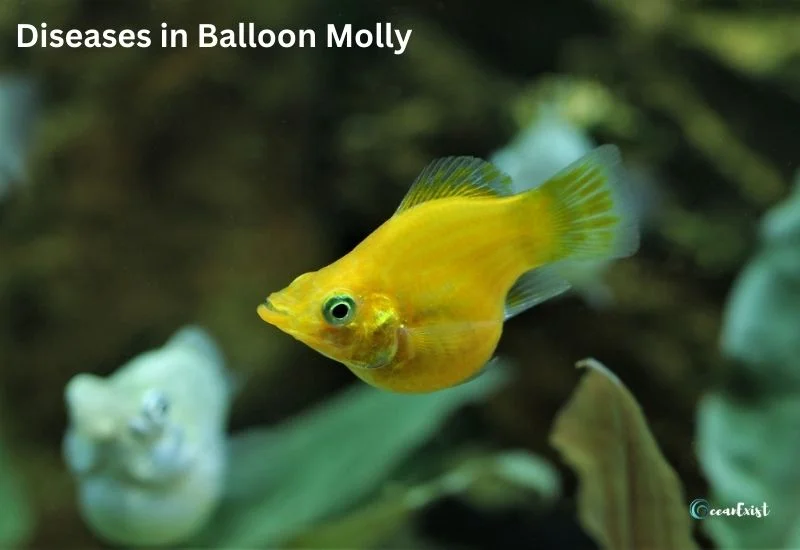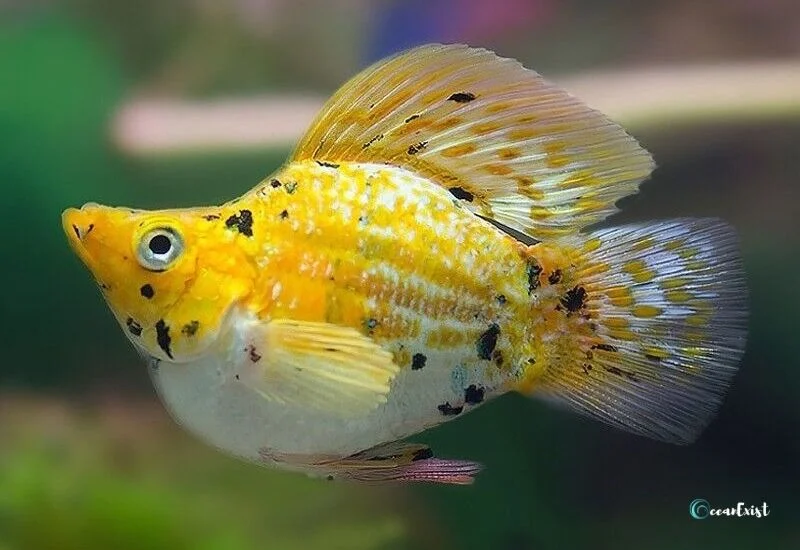Balloon Molly fish are among the most popular species, with vibrant colors and energetic natures. The Mollies have low maintenance and care requirements.
As the name suggests, Balloon Mollies have round, swollen bellies with extended dorsal fins. They grow in a short and rounded manner. Balloon Mollies are often known as beginner-friendly fish as they love to live in a family of other peaceful species with similar natures and characteristics.
They are usually found and bred in fresh or salty water. So, you must add a teaspoon of salt to 5 gallons of water.
Balloon Mollies are the best choice for cleaning the aquarium by collecting waste with their flat mouths from the aquarium.
Balloon Mollies have multiple varieties, such as Poecilia latipinna (sailfin molly) and Poecilia sphenops (short-fin molly). Balloon Mollies are also selectively bred with other species and result in a hybrid breed such as black, balloon, gold dust, marble, creamsicle, dalmatian, and other variations.
Balloon Molly Fish Species Overview
| Scientific Name | Poecilia sphenops |
| Family | Poeciliidae |
| Behavior | Social/Friendly |
| Breeding | Breed in fresh and salty water |
| Popular For | Beginner Friendly nature |
| Popular characteristic | Known for collecting waste and cleaning aquariums |
| Life span | Short (3-5 years) |
| pH | High pH (7.5-8.5) |
| Temperature | 78F |
| Nature | Peaceful |
| Tank Size | 12 gallons for small-sized and 30 gallons for large-sized fish |
| Origin | South and Central America, Mexico |
Types Of Balloon Mollies:
There are several types of balloon mollies that can enhance the beauty of your aquariums with their wonderful coloring and sizes.
Dalmatian:
These mollies have white, cream-colored bodies with some black spots, which give a Dalmatian-like appearance.
Silver Belly:
These mollies have a silver-colored body. When they swim in the water, they reflect metallic shine, enhancing the overall aquarium’s beauty.
Gold Pot Belly:
These balloon mollies have a golden-colored body with a metallic shine on their body. These mollies are very popular due to their rustless color. These Gold pot Belly types are very easy to care for.
Lyretail Fish:
Lyretall balloon mollies have lyretail-shaped fins that are larger than those of other balloon mollies.
How to Set Up an Aquarium for Mollies?

Aquarium type and size will depend on the type of Molly fish. Some mollies require a bigger space, like an aquarium with 30-55 gallons of water will be required for large-sized mollies. But, some small and medium-sized mollies can live perfectly in a 12-gallon water-capacity aquarium.
You may also need a heater aquarium if you want to make a domestic home for Balloon mollies. These aquariums will be required to maintain water temperature in the range of 75-80°F (24-27°C).
Some people use kitchen salt in the aquarium to provide them with a natural habitat for them. But this can cause itchiness to their skin. So, I always recommend using aquarium salt, which is good for their healthy environment and also enhances the qualities of their natural habitat.
What Are the Best Tankmates For Balloon Molly Fish?
Balloon mollies are small, peaceful fish that live in a community and possess a friendly nature. Species of fish with aggressive natures and fast-moving behaviors are not a good choice to coexist with them.
Here is a list of species that may become best mates with Molly fish.
- Danios
- Dwarf Gourami
- Rosy barbs
- Zebra loaches
- Corydoras catfish
- Tetras
Diet and Nutrient Requirements For Balloon Mollies:

Balloon mollies have a very simple food diet. They are omnivores and enjoy eating various types of food, from fish flakes and pellets to live frozen foods. They can digest any fish food you drop in the aquarium. Their food can consist of a mixture of proteins and vegetables.
Mollies are not usually considered great algae eaters, but they sometimes snack on plant-based foods like lettuce and spinach.
You should consider eating live food twice a week. It will be a great addition to their body’s extra protein and nutrients.
Always be careful with the behavior of Balloon mollies while eating. If you observe that they usually fight when you drop off some food in the water, consider eating their food, which scatters all through the aquarium. In this case, you should avoid eating fish flakes and pellets.
If you observe any unusual feces, like long-string feces, you are overfeeding them. So, you must lower the quantity of food you are feeding.
How Much To Feed Them?
A common rule of thumb is that their stomach is the same size as one of their eyes. So, always keep this in mind when you eat them and do not overthrow food in the aquarium. Always check if there is food available for them. I suggest you take some breaks and feed them in batches for their best stomach digestion performance and their healthy living.
How To Breed Balloon Mollies?
Breeding Balloon Mollies is not a challenging task. If you have provided them with the right aquarium size, better water parameters, and optimal temperature, you can easily breed them in your captive environment.
You should be able to differentiate between male and female mollies. We always recommend keeping more female mollies in the aquarium than male ones. Because male mollies tease and harass female mollies, which causes them stress and may cause diseases in them.
Male mollies have pointed anal fins which grow larger than female ones. Female anal fins have rounded shape, and they have pregnancy spots too.
A new female molly can only give birth to a handful of babies. However, a veteran mom with previous pregnancy experiences can give birth to 50-60 mollies in a single time.
You should always keep Balloon Mollie’s parents separate from their babies. Male mollies usually prey on their newborn babies and eat them. You can also grow a lot of plant-based decor like water sprites and water wisteria in the aquarium to provide them with hidden private places.
Balloon mollies are livebearers (belonging to the Poeciliidae family), meaning they give birth to mollies larger than newborns’ tiny fry. These babies are already grown in size and ready to eat food prepared for mature mollies, like plant-based food, live baby brine shrimps, and Repashy gel food (in powder form).
Female mollies often select the male with more strength for mating. During mating, male Balloon Molly shows his happiness to his female partner, which allows the female to fertilize her eggs.
If you want to increase the survival rate of newborn molly babies, you should make a separate aquarium for breeding. The temperature of this aquarium must be up to 78 degrees Fahrenheit.
Balloon Molly Origin And Habitat:
Balloon mollies mainly originate from the regions of North and Central America. We can easily find them in rivers and freshwater streams in these areas. With their jolly nature and vibrant coloring, they have become popular aquarium pets.
Balloon Molly Behavior & Temperament:
Balloon Molly fish are very easy to bring up in domestic aquariums. They are schooling fish, which means that they like to live with other fish of similar species. You must keep a group of a minimum of 4 mollies. If they are kept alone, they might show aggression.
Always keep more females than males. Otherwise, males will harass females during mating.
Common Balloon Mollies Diseases:

Generally, Balloon Mollies are healthy and have a robust immune system. However, like any other fish, Balloon mollies may suffer from diseases.
Here are some common diseases in Balloon mollies:
Shimmies:
This disease is commonly found in livebearer species. Shimmying is a state where the whole body shakes in an abnormal way. Shimmying in mollies causes their fins to clamp, heads to shake promptly, and they don’t comfortably breathe.
What Causes Shimmies?
Shimmies occur when mollies are not comfortable in their environment. Shimmies in mollies occur due to stress caused by improper water conditions. When these fish are kept in too salty or soft water, they suffer from shimmies.
In this disease, a fish doesn’t have full control over their muscles and nerves.
How To Cure Shimmies In Mollies?
There is no proper treatment of shimmies in mollies. When the water conditions get better with the passage of time, the shimmying effect disappears. So you don’t have to change things abruptly. Sudden changes in the water can also cause stress, resulting in diseases.
Velvet:
Velvet disease is also called goldfish disease, rust, and coral disease. Dinoflagellate parasites cause this fish disease in freshwater. When a Balloon molly gets infected by this disease, their color changes to brownish-gold color.
What Causes Velvet?
Whenever there are changes in water conditions, temperature changes, or mollies get frustrated, they suffer from Velvet disease. The velvet is caused by Oödinium.
In this disease, Mollies flicker their body, clam their fins, -shrink their bodies, and lose weight. In Velvet disease, molly fish color starts peeling off.
How To Cure Velvet In Mollies?
Keeping the lights low or turning off the lights will help to kill Oödinium. Proper medication and keeping the temperature high up to 80 degrees Fahrenheit will help to kill off the manifestation.
Conclusion:
In conclusion, balloon mollies have vivid colors and a lively nature. They are very easy to care for, which is why they are popular with aquarium enthusiasts. They have a very short life span, and they don’t grow much larger in size. The balloon mollies have rounded bodies with large dorsal fins.
They are habitual of living in freshwater. Always provide them with optimal water conditions, suitable temperature, and a balanced oxygenated flow of water.
Balloon mollies can lay eggs up to 50-60 after every two months. Do not keep parent mollies and newborns fries with each other as parent mollies may harm their babies.
Balloon mollies may suffer from disease, which can be cured with pristine water conditions and an optimum ideal environment.
